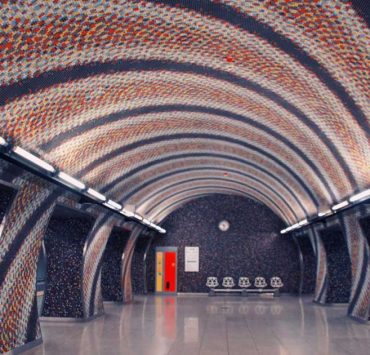What’s happening in Budapest? The city will continue to expand, beautify, renovate, refurbish and grow well into the next decade – and beyond.
Many of the planned changes have already begun and construction is scheduled to continue for at least the next ten years. The city will explode with new parks and monuments, new museums and university buildings. There will be new office buildings and even Budapest’s first skyscraper. Bigger and better sports complexes are planned as well as new venues for the arts. New construction and renovations will be common sights throughout Budapest during the coming years, and its cityscape will be forever altered for future generations.
Here are some of the biggest plans for the future.
What’s Happening in Budapest: Parks and Green Spaces
The biggest renovation everyone is waiting for is the refurbishment of Millenáris Park, and the transformation of the adjoining vacant lot into a leisure park. To further enhance the upgraded venue, an underground parking garage will be constructed, after which the community area will be beautified with hundreds of new trees, benches and a playground.
The garden area surrounding the Hungarian National Museum may be completely restyled to become a new and hopefully-beloved inner-city green oasis. The rather tacky parking lot presently inside the fenced area will be removed, the flora and fauna will be revived, and cozy spots suitable for picnics will be added. In addition, the nearby historical houses of Pollack Mihány Square in the Palotanegyed (Palace Quarter) will be renovated.

One of the most ambitious near-future projects is the renewal of the Pest side of the Danube riverbank, all the way from Fővám Square to Kossuth Square. The current roads and crash barriers will be replaced with pedestrian-friendly walkways, ornate cladding and strictly controlled traffic. And on the Danube itself, city dwellers will find new and exciting floating platforms. The iconic pillar at Erzsébet Bridge’s Pest side will be transformed into a green area, with a bikeway and thoroughfare. The bland parking lot in front of the Hungarian Academy of Sciences will give way to an expanded park, and the Belgrade Quay will become a more attractive area, lined with cafés and restaurants.
Tree-planting program
A tree-planting program, begun, in 2016, saw a total of 10,000 new trees planted in more than 80 locations throughout the city. An even more grandiose project is also underway: the Liget Budapest project will be a complete overhaul of the entirety of City Park, including the expansion of green areas, restored historical pavilions and bringing back the original state of the lake, along with making Nádor Island more stroller-friendly.
The area between Nyugati train station and Podmaniczky Street is slated for a large community park. The plans include grassy areas, a hill for sledding, a pétanque pitch and running tracks; however, this project is still in the early planning phases.
What’s Happening in Budapest: Office and Residential
Ambitious plans abound for increasing the amount of office space in Budapest, along with more new residential developments.
An office building designed by Dezső Cserba has long been standing vacant and unused on Múzeum Avenue, but plans are in the works to transform this historic building into loft flats.
The historic building at Király Street 40, designed by renowned Hungarian architect József Hild, was almost completely destroyed due to negligence over the past decades. The original façade will be restored and the interior will become a new residential building housing more than 100 flats.

And in one of the biggest and most ambitious moves to date, a whole new quarter will be built near Kopaszi Dam. The project will feature new office buildings and residential properties, separated by a long shopping street, and plans also include a sports field, hotel, nursery, and possibly even a skyscraper.
Other planned residential projects include:
Several multi-story “green” residential properties in the area between Szent István Square and the Danube in Újpest.
An initial 268 new apartment blocks in Újbuda, followed by 438 more in the future.
The construction of 1,500 new residential properties at various locations around Budapest, including Nagy Diófa Street, Corvin Promenade and in the Zugló district.
Széll Kálmán Square’s postal palace will see new use as an office building. The tower of this eight-story building will also be open to the public, providing lovely panoramic views of the Buda Castle, Vérmező and Hűvösvölgy.
The renovation of the Stock Exchange Palace may begin this year, to include modern and state-of-the-art offices and stores.

Ericsson’s new headquarters will be the company’s biggest research and development center outside their home country, and will employ nearly 1,800 people.
A new office block called Hillside Offices will be established next to the MOM Park shopping center.
Graphisoft Park on the Buda side is being continually upgraded and expanded.And finally, Budapest ONE Business Park is scheduled to be built in Őrmező; it will serve as a modern multi-modal public-transportation hub near the terminus of Metro 4.
What’s Happening in Budapest: Historical Buildings
The complete renovation of the Buda Castle is ongoing, including the reconstruction of several buildings that were damaged or destroyed during World War II. The plans include the renovation of several buildings designed by Alajos Huszmann, such as the Csikós Court and its surroundings, the ornate riding hall and its corresponding barn, the so-called Főőrségi (Main Guard’s) building, the Stöckl stairs, and the tower of Karakas Pasha.
The reconstruction of the Carmelite Church and Monastery, as well as the construction of the Prime Minister’s new office in the Castle District, has already begun.
Vajdahunyad Castle will get a facelift as part of the Liget Budapest project for the beautification of City Park.

The Hungarian House of Music will also see a new contemporary refurbishment. The new and improved building will introduce and popularize music history, folk traditions, music pedagogy, and contemporary Hungarian music culture. In fact, the glass-walled edifice may eventually become Budapest’s primary musical center, like the Cité de la Musique in Paris.
Museum projects
The Museum of Ethnography will relocate to City Park. The new building will be partially underground and will feature motifs of folk art. It will house a café with a terrace, a panoramic glass-walled library, a children’s museum and a cinema hall.
The demolished parts of the Museum of Transport building will be restored and expanded by two underground floors, with a lookout tower in the dome.
The complete reconstruction and expansion of the Museum of Applied Arts have also begun. The refurbished building will help to preserve historical values and will incorporate new exhibition methods. In addition, the renovation of the Museum of Fine Arts is scheduled for completion within the next year or so. As part of the Liget Budapest project, the National Museum Restoration and Storage Center (OMRRK) will be located on the site of the former Szabolcs Street Hospital.
One of the most iconic buildings of Budapest, Párisi Udvar (Paris Court) on Ferenciek Square, is still undergoing renewal.
The refurbishment of The Tomb of Gül Baba, along with its terraced garden and park, may also be completed within a few months. This well-known memorial site will boast new ceramic cladding. The columns surrounding the octagonal Ottoman tomb will be constructed of carved quarry stone. A museum and a café will enhance the site.
What’s Happening in Budapest: Hotels
Budapest’s historic Drechsler Palace, just across from the Opera House on Andrássy Avenue, formerly housed the city’s Ballet Institute, in addition to several other enterprises over the years. It will now enter the next phase of its life as a deluxe W Hotel. The building was originally constructed in 1898. The interior and exterior of the building will be completely refurbished, and the new W Budapest will have 162 stylish contemporary guest rooms and one luxurious royal suite, in addition to conference rooms, a bar and a restaurant.

The southern wing of Klotild Palace, also known as Matild Palace, will become a luxuy 156-room hotel. As one result of the renovation, select portions of the Belvárosi Kávéház (Central Café) will be housed in the hotel, and an open-kitchen Turkish restaurant will also be included.
The construction of a new hotel by the Liszt Ferenc International Airport is scheduled for completion late in 2018. A covered walkway will connect the five-floor complex with the airport’s terminals.

Clark Ádám Square will be home to another new hotel. In addition, a 184-room hotel is being erected next to the Great Market Hall. The building housing the former telephone exchange in District VIII may also reopen as a hotel. Budapest’s main telephone exchange operated here between 1917 and 2007. The former Postal Palace building in downtown Budapest will house a luxurious hotel in the future.
Reconstructions and renovations
The Olof Palme House has served as a military hospital, a café, a beer bar, an office building, and a dance school. After its renovation as part of the Liget Budapest Project, it will then be able to host cultural and hospitality functions.
Budapest’s Old City Hall stands opposite the Matthias Church in the Castle District. The City Hall of Buda was seated here until 1873, but the building was mostly destroyed during the 20th century. Following restoration and modernization, it will mainly serve educational purposes, with the addition of a restaurant and a bookstore.
The Zichy Palace of Óbuda, which houses the Vasarely Museum, will also be renovated and modernized. The edifice’s façade, lighting, and interior design will be renewed. In addition, the Federation of Technical and Scientific Societies building at Kossuth Square in Budapest will be reconstructed to suit contemporary needs.

Modernization
The Újpest district’s new city center is already under construction. The finished product will be a covered market hall and cultural center, with a rooftop garden and a basement garage. A large square with green areas and pavilions will also provide a suitable venue for major events.
District III will see the raising of a new Market Hall suitable for hosting cultural events. In addition, the district’s Heltai Jenő Square will be refurbished with the inclusion of a new swimming pool.
The Millenáris Center will also be renovated and will house the National Dance Theater. The high-quality dance institute will offer a home to the representatives of traditional and contemporary dance culture.
Népliget might become a large bicycle park, replete with a two-kilometer round recreational area, a three-kilometer concrete path, BMX- and mountain-bike parks and a skatepark. Also, a “Fradiváros” – a large stadium able to accommodate volleyball players, athletes, hockey players, wrestlers, and various other sports – is among the future plans.
The changing rooms, buffet, ventilation system, roof, courtyard, inner façade, and the complete water system of the Császár Komjádi Sports Swimming Center will soon be modernized. The building will also be expanded to include a doctor’s office, two large saunas and three new gym halls.

Baths&Pools
The reconstruction of a Bauhaus-style national monument, the Palatinus Swimming Pool, is already underway. The façade will be restored to its original plan and a wellness and fitness area will be established in the basement. The original changing rooms will be renovated, the restaurant at the entrance will be refurbished and expanded, and the thermal pool will be covered, so that the water park can stay open all year round.
There’s also a complete renovation in store for the Király Baths. The original bath was built by Arszlán Pasha in 1565, and behind the building’s classical façade can still be found a bath that evokes the atmosphere of the Balkans.

Sports venues
Hungarian sports officials plan to welcome international teams and eager fans with brand-new and truly spectacular sports venues in the event Budapest is chosen as the site for future Olympic Games. Athletes and coaches will travel via the quickest and most cost-effective route: on the Danube. And after the events, the facilities used to house athletes and visitors can be used as dormitories.
Following the demolishment of Puskás Stadium, the construction of a new stadium may begin. Some original elements of the edifice might be retained; for example, the building’s tower might become a museum for stadium tours. A maximum of 67,000 seats will be installed inside.
Within the next few years, a biodome will be built inside the Budapest Zoo, providing many animals an enclosed year-round hothouse environment similar to their own original habitats. The new indoor enclosure will have rich flora, a small river suitable for boat rides, an educational area and exhibition corridors.

In 2016, Budapest’s Lechner Knowledge Center announced a competition for creative design plans for the renewal and rejuvenation of one of the most mesmerizing natural sights of the Magyar metropolis – Gellért Hill – and the UNESCO World Heritage landmark at its panoramic peak. A total of 68 entries were submitted, of which 14 were selected for final review; however, the final concept and the future look of Gellért Hill has not yet been determined.
What’s Happening in Budapest in the Distant Future
There are also a couple of project plans for the more distant future. The biggest would see the addition of two more bridges over the Danube. A railway line connecting Budapest with the Liszt Ferenc Airport might be established; high-speed trains would travel mostly underground every 20 minutes from downtown. In addition, the airport could also be accessed by train directly from other Hungarian cities, such as Debrecen, Szeged and Miskolc.




